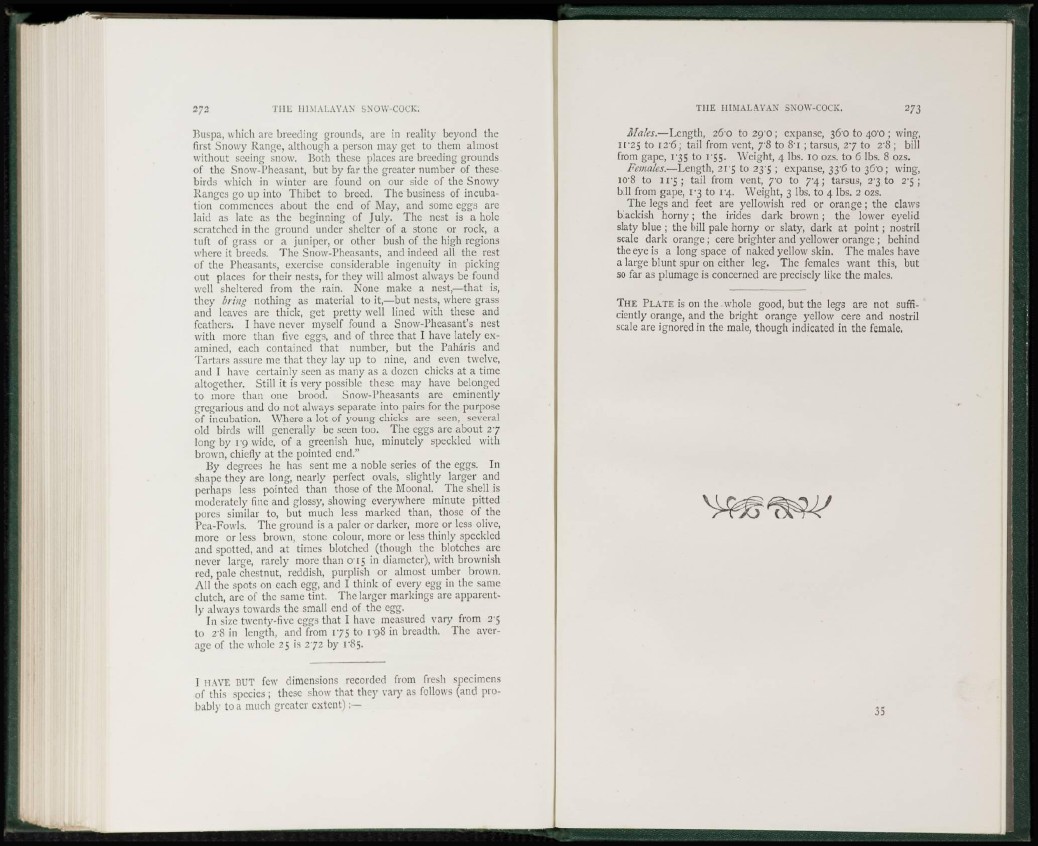
Buspa, which are breeding grounds, are in reality beyond the
first Snowy Range, although a person may get to them almost
without seeing snow. Both these places are breeding grounds
of the Snow-Pheasant, but by far the greater number of these
birds which in winter are found on our side of the Snowy
Ranges go up into Thibet to breed. The business of incubation
commences about the end of May, and some eggs are
laid as late as the beginning of July. The nest is a hole
scratched in the ground under shelter of a stone or rock, a
tuft of grass or a juniper, or other bush of the high regions
where it breeds. The Snow-Pheasants, and indeed all the rest
of the Pheasants, exercise considerable ingenuity in picking
out places for their nests, for they will almost always be found
well sheltered from the rain. None make a nest,—that is,
they bring nothing as material to it,—but nests, where grass
and leaves are thick, get pretty well lined with these and
feathers. I have never myself found a Snow-Pheasant's nest
with more than five eggs, and of three that I have lately examined,
each contained that number, but the Panaris and
Tartars assure me that they lay up to nine, and even twelve,
and I have certainly seen as many as a dozen chicks at a time
altogether. Still it is very possible these may have belonged
to more than one brood. Snow-Pheasants are eminently
gregarious and do not always separate into pairs for the purpose
of incubation. Where a lot of young chicks are seen, several
old birds will generally be seen too. The eggs are about 27
long by 19 wide, of a greenish hue, minutely speckled with
brown, chiefly at the pointed end."
By degrees he has sent me a noble series of the eggs. In
shape they are long, nearly perfect ovals, slightly larger and
perhaps less pointed than those of the Moonal. The shell is
moderately fine and glossy, showing everywhere minute pitted
pores similar to, but much less marked than, those of the
Pea-Fowls. The ground is a paler or darker, more or less olive,
more or less brown, stone colour, more or less thinly speckled
and spotted, and at times blotched (though the blotches are
never large, rarely more than 015 in diameter), with brownish
red, pale chestnut, reddish, purplish or almost umber brown.
All the spots on each egg, and I think of every egg in the same
clutch, arc of the same tint. The larger markings are apparently
always towards the small end of the egg.
In size twenty-five eggs that I have measured vary from 25
to 28 in length, and from 175 to 1 98 in breadth. The average
of the whole 25 is 272 by 1-85.
I HAVE RUT few dimensions recorded from fresh specimens
of this species ; these show that they vary as follows (and probably
to a much greater extent) :—
Minks.—Length, 260 to 290 ; expanse, 360 to 40'0 ; wing,
I U25 to I2'6 ; tail from vent, 7'8 to 8'I ; tarsus, 27 to 2'8 ; bill
from gape, I'35 to I"5S- Weight, 4 lbs. 10 ozs. to 6 lbs. 8 ozs.
Finíales.—Length, 215 to 235 ; expanse, 33'6 to 36x1; wing,
I0'8 to i i ' 5 ; tail from vent, 70 to 7 4 ; tarsus, 23 to 2'5 ;
bill from gape, I "3 to I'4. Weight, 3 lbs. to 4 lbs. 2 ozs.
The legs and feet are yellowish red or orange ; the claws
blackish horny; the irides dark brown ; the lower eyelid
slaty blue ; the bill pale horny or slaty, dark at point ; nostril
scale dark orange ; cere brighter and yellower orange ; behind
the eye is a long space of naked yellow skin. The males have
a large blunt spur on either leg. The females want this, but
so far as plumage is concerned arc precisely like the males.
THE PLATE is on the-whole good, but the legs are not sufficiently
orange, and the bright orange yellow cere and nostril
scale are ignored in the male, though intlicated in the female.